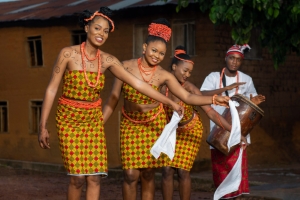Eastern and Southern Africa boast a rich and diverse culinary heritage, reflecting the unique cultures, traditions, and landscapes of the region. From hearty stews and savory meats to refreshing drinks and street foods, the region’s food will satisfy any palate.
Here’s a guide to what you should eat and drink when exploring these captivating destinations.
1. Traditional Dishes to Try
Kenya – Nyama Choma & Ugali
Nyama Choma (roasted meat) is a beloved Kenyan dish, often served with a side of vegetables and the staple Ugali, a dense, cornmeal-based dish.
What to Try: Visit a “nyama choma” grill house for skewers of marinated beef, goat, or chicken, served with kachumbari (a fresh tomato and onion salad).
South Africa – Biltong & Bunny Chow
Biltong, a dried, cured meat similar to jerky, is a must-try snack. It’s commonly made from beef or game meat like ostrich.
Bunny Chow, originating from Durban, is a unique South African street food consisting of curry served in a hollowed-out loaf of bread.
Tanzania – Nyama na Ugali & Samosa
Nyama na Ugali is the Tanzanian version of a meat and cornmeal combo. Samosas, crispy pockets filled with spiced meat or vegetables, are popular snacks.
What to Try: Savor chapati (flatbread) with stews like nyama ya mbuzi (goat meat) for a true Tanzanian flavor experience.
Zimbabwe – Sadza & Mopane Worms
Sadza is Zimbabwe’s national dish, a thick cornmeal porridge often eaten with a variety of stews, vegetables, and meats.
Mopane Worms, though considered an acquired taste, are a delicacy in Zimbabwe. These protein-packed insects are typically dried or fried.
Madagascar – Romazava & Mofo Gasy
Romazava, a delicious stew made with meat and greens, is considered the national dish of Madagascar.
Mofo Gasy, a Malagasy pancake, is often enjoyed for breakfast or as a snack, typically served with sweet condensed milk.
Zambia – Ifisashi & Nshima
Ifisashi is a traditional Zambian dish made with vegetables (like spinach) cooked in peanut sauce, often served with Nshima, a type of cornmeal porridge.
What to Try: Zambians enjoy their food with a bit of Chibwantu, a traditional millet beer, which pairs well with hearty dishes.
Namibia – Kapana & Potjiekos
Kapana is Namibian street food consisting of freshly grilled meat served with a variety of condiments, such as chili sauce and pap (maize porridge).
Potjiekos, a traditional stew made with meat, vegetables, and spices, is perfect for a hearty meal after a day of exploring.
Uganda – Rolex & Matoke
Rolex, not the luxury watch, but a street food consisting of eggs and vegetables wrapped in a chapati, is a must-try for anyone visiting Uganda.
Matoke, or Ugandan plantains, are often served with beans or meat dishes, providing a wholesome accompaniment to the meal.
2. Local Drinks to Try
South Africa – Wine & Amarula
South Africa is world-renowned for its wine production, particularly its Pinotage and Chenin Blanc.
Amarula, a creamy, fruit-based liqueur made from marula fruit, is popular throughout Southern Africa and often enjoyed as a cocktail.
Kenya – Chai & Tusker Beer
Chai (tea) is a staple drink in Kenya, typically served with milk and sugar.
Tusker, a light lager, is the most famous Kenyan beer, perfect for relaxing after a long day of sightseeing.
Tanzania – Uji & Safari Lager
Uji, a porridge-like drink made from millet or sorghum, is a common breakfast drink in Tanzania.
For beer lovers, Safari Lager is Tanzania’s go-to brew, offering a refreshing taste of local flavor.
Madagascar – Ranon’Apango & Beer
Ranon’Apango is a Malagasy drink made from burnt rice, which is boiled and then served with water. It has a smoky, refreshing flavor.
Local Malagasy beers, such as THB (Three Horses Beer), are also widely enjoyed.
Uganda – Ajon & Club Pilsner
Ajon is a traditional Ugandan fermented drink made from millet, sorghum, or maize, often served during special events and celebrations.
Club Pilsner is one of Uganda’s most popular beers and is a great way to unwind after exploring the country’s stunning landscapes.
3. Street Food You Can’t Miss
Street food is a fun and authentic way to dive into a country’s culinary culture. In most African cities, vendors offer a variety of tasty treats.
- Samosas (Tanzania, Kenya): Crispy triangles filled with spicy meat or vegetables.
- Chingwa & Mandazi (Uganda, Kenya): Fried doughnuts often enjoyed with tea or as a snack.
- Boerewors (South Africa): A traditional sausage, often grilled and served with a roll and tomato sauce.
4. How to Eat Safely
While exploring local cuisines, it’s important to keep a few safety tips in mind:
- Drink bottled water in countries where tap water isn’t safe.
- Eat at busy local spots: A lot of traffic can indicate fresh food and high standards of hygiene.
- Be cautious with street food: Ensure that the food is hot and freshly prepared to avoid any issues with foodborne illnesses.
Conclusion
Whether you’re indulging in nyama choma in Kenya, sipping amarula in South Africa, or enjoying mofo gasy in Madagascar, Eastern and Southern Africa offer a unique, mouthwatering culinary experience.
Dive into the rich flavors of the region, and remember to eat safely and responsibly for a rewarding food journey.








